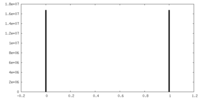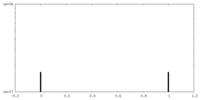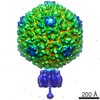[English] 日本語
 Yorodumi
Yorodumi- EMDB-29675: A Vibrio cholerae viral satellite enables efficient horizontal tr... -
+ Open data
Open data
- Basic information
Basic information
| Entry |  | |||||||||||||||||||||
|---|---|---|---|---|---|---|---|---|---|---|---|---|---|---|---|---|---|---|---|---|---|---|
| Title | A Vibrio cholerae viral satellite enables efficient horizontal transfer by using an external scaffold to assemble hijacked coat proteins into small capsids | |||||||||||||||||||||
 Map data Map data | ||||||||||||||||||||||
 Sample Sample |
| |||||||||||||||||||||
 Keywords Keywords | PLE / Procapsid / VIRUS LIKE PARTICLE | |||||||||||||||||||||
| Function / homology | Major capsid protein GpE / Phage major capsid protein E / host cell cytoplasm / Putative major head protein / Phage protein Function and homology information Function and homology information | |||||||||||||||||||||
| Biological species |   Vibrio phage ICP1_2011_A (virus) Vibrio phage ICP1_2011_A (virus) | |||||||||||||||||||||
| Method | single particle reconstruction / cryo EM / Resolution: 3.4 Å | |||||||||||||||||||||
 Authors Authors | Subramanian S / Boyd CM / Seed KD / Parent KN | |||||||||||||||||||||
| Funding support |  United States, 6 items United States, 6 items
| |||||||||||||||||||||
 Citation Citation |  Journal: Elife / Year: 2024 Journal: Elife / Year: 2024Title: A viral satellite maximizes its spread and inhibits phage by remodeling hijacked phage coat proteins into small capsids. Authors: Caroline M Boyd / Sundharraman Subramanian / Drew T Dunham / Kristin N Parent / Kimberley D Seed /  Abstract: Phage satellites commonly remodel capsids they hijack from the phages they parasitize, but only a few mechanisms regulating the change in capsid size have been reported. Here, we investigated how a ...Phage satellites commonly remodel capsids they hijack from the phages they parasitize, but only a few mechanisms regulating the change in capsid size have been reported. Here, we investigated how a satellite from , phage-inducible chromosomal island-like element (PLE), remodels the capsid it has been predicted to steal from the phage ICP1 (Netter et al., 2021). We identified that a PLE-encoded protein, TcaP, is both necessary and sufficient to form small capsids during ICP1 infection. Interestingly, we found that PLE is dependent on small capsids for efficient transduction of its genome, making it the first satellite to have this requirement. ICP1 isolates that escaped TcaP-mediated remodeling acquired substitutions in the coat protein, suggesting an interaction between these two proteins. With a procapsid-like particle (PLP) assembly platform in , we demonstrated that TcaP is a bona fide scaffold that regulates the assembly of small capsids. Further, we studied the structure of PLE PLPs using cryogenic electron microscopy and found that TcaP is an external scaffold that is functionally and somewhat structurally similar to the external scaffold, Sid, encoded by the unrelated satellite P4 (Kizziah et al., 2020). Finally, we showed that TcaP is largely conserved across PLEs. Together, these data support a model in which TcaP directs the assembly of small capsids comprised of ICP1 coat proteins, which inhibits the complete packaging of the ICP1 genome and permits more efficient packaging of replicated PLE genomes. | |||||||||||||||||||||
| History |
|
- Structure visualization
Structure visualization
| Supplemental images |
|---|
- Downloads & links
Downloads & links
-EMDB archive
| Map data |  emd_29675.map.gz emd_29675.map.gz | 251.2 MB |  EMDB map data format EMDB map data format | |
|---|---|---|---|---|
| Header (meta data) |  emd-29675-v30.xml emd-29675-v30.xml emd-29675.xml emd-29675.xml | 17.6 KB 17.6 KB | Display Display |  EMDB header EMDB header |
| FSC (resolution estimation) |  emd_29675_fsc.xml emd_29675_fsc.xml | 21.1 KB | Display |  FSC data file FSC data file |
| Images |  emd_29675.png emd_29675.png | 206.6 KB | ||
| Masks |  emd_29675_msk_1.map emd_29675_msk_1.map | 824 MB |  Mask map Mask map | |
| Filedesc metadata |  emd-29675.cif.gz emd-29675.cif.gz | 6 KB | ||
| Others |  emd_29675_half_map_1.map.gz emd_29675_half_map_1.map.gz emd_29675_half_map_2.map.gz emd_29675_half_map_2.map.gz | 760.5 MB 760.5 MB | ||
| Archive directory |  http://ftp.pdbj.org/pub/emdb/structures/EMD-29675 http://ftp.pdbj.org/pub/emdb/structures/EMD-29675 ftp://ftp.pdbj.org/pub/emdb/structures/EMD-29675 ftp://ftp.pdbj.org/pub/emdb/structures/EMD-29675 | HTTPS FTP |
-Validation report
| Summary document |  emd_29675_validation.pdf.gz emd_29675_validation.pdf.gz | 914.9 KB | Display |  EMDB validaton report EMDB validaton report |
|---|---|---|---|---|
| Full document |  emd_29675_full_validation.pdf.gz emd_29675_full_validation.pdf.gz | 914.4 KB | Display | |
| Data in XML |  emd_29675_validation.xml.gz emd_29675_validation.xml.gz | 28.7 KB | Display | |
| Data in CIF |  emd_29675_validation.cif.gz emd_29675_validation.cif.gz | 37.9 KB | Display | |
| Arichive directory |  https://ftp.pdbj.org/pub/emdb/validation_reports/EMD-29675 https://ftp.pdbj.org/pub/emdb/validation_reports/EMD-29675 ftp://ftp.pdbj.org/pub/emdb/validation_reports/EMD-29675 ftp://ftp.pdbj.org/pub/emdb/validation_reports/EMD-29675 | HTTPS FTP |
-Related structure data
| Related structure data |  8g1rMC M: atomic model generated by this map C: citing same article ( |
|---|---|
| Similar structure data | Similarity search - Function & homology  F&H Search F&H Search |
- Links
Links
| EMDB pages |  EMDB (EBI/PDBe) / EMDB (EBI/PDBe) /  EMDataResource EMDataResource |
|---|
- Map
Map
| File |  Download / File: emd_29675.map.gz / Format: CCP4 / Size: 824 MB / Type: IMAGE STORED AS FLOATING POINT NUMBER (4 BYTES) Download / File: emd_29675.map.gz / Format: CCP4 / Size: 824 MB / Type: IMAGE STORED AS FLOATING POINT NUMBER (4 BYTES) | ||||||||||||||||||||
|---|---|---|---|---|---|---|---|---|---|---|---|---|---|---|---|---|---|---|---|---|---|
| Voxel size | X=Y=Z: 1.328 Å | ||||||||||||||||||||
| Density |
| ||||||||||||||||||||
| Symmetry | Space group: 1 | ||||||||||||||||||||
| Details | EMDB XML:
|
-Supplemental data
-Mask #1
| File |  emd_29675_msk_1.map emd_29675_msk_1.map | ||||||||||||
|---|---|---|---|---|---|---|---|---|---|---|---|---|---|
| Projections & Slices |
| ||||||||||||
| Density Histograms |
-Half map: #2
| File | emd_29675_half_map_1.map | ||||||||||||
|---|---|---|---|---|---|---|---|---|---|---|---|---|---|
| Projections & Slices |
| ||||||||||||
| Density Histograms |
-Half map: #1
| File | emd_29675_half_map_2.map | ||||||||||||
|---|---|---|---|---|---|---|---|---|---|---|---|---|---|
| Projections & Slices |
| ||||||||||||
| Density Histograms |
- Sample components
Sample components
-Entire : PLE Procapsid
| Entire | Name: PLE Procapsid |
|---|---|
| Components |
|
-Supramolecule #1: PLE Procapsid
| Supramolecule | Name: PLE Procapsid / type: complex / ID: 1 / Parent: 0 / Macromolecule list: all |
|---|---|
| Source (natural) | Organism:  |
-Macromolecule #1: major head protein
| Macromolecule | Name: major head protein / type: protein_or_peptide / ID: 1 / Number of copies: 4 / Enantiomer: LEVO |
|---|---|
| Source (natural) | Organism:  Vibrio phage ICP1_2011_A (virus) Vibrio phage ICP1_2011_A (virus) |
| Molecular weight | Theoretical: 38.428023 KDa |
| Recombinant expression | Organism:  |
| Sequence | String: MARMGDFGVV DYTSLMALAP RSKNFLELLG VFSESNTRYI DSRYAEFERE EKGVTKMNAM ARGGSRKYIG SEKARKEIIE VPFAPLDGV TVASEVEAFR QYGTESQTAS VEALVQRKIE HIQRSHGIYI RDCQYTALLK DKILAEDEDG NEITALAKNF S TLWGVSRK ...String: MARMGDFGVV DYTSLMALAP RSKNFLELLG VFSESNTRYI DSRYAEFERE EKGVTKMNAM ARGGSRKYIG SEKARKEIIE VPFAPLDGV TVASEVEAFR QYGTESQTAS VEALVQRKIE HIQRSHGIYI RDCQYTALLK DKILAEDEDG NEITALAKNF S TLWGVSRK TGAINTTTAV NPFSVLATKR QEIIDSMGEN NGFTSMVVLC TTRDFNAIVD HPDVRAAYEG RDGGAEYLTR RL GDAVDFQ VFTHKGVTLV EDTSGKLTDG SAYMFPLGVQ DMFQAVYAPA DSTDHVNTIS QGSYLFLNAG ENWRRDVIES EVS YACMVT RSELICDLTI TVAHHHHHH UniProtKB: Putative major head protein |
-Macromolecule #2: Serine protease
| Macromolecule | Name: Serine protease / type: protein_or_peptide / ID: 2 / Number of copies: 1 / Enantiomer: LEVO |
|---|---|
| Source (natural) | Organism:  |
| Molecular weight | Theoretical: 33.231152 KDa |
| Recombinant expression | Organism:  |
| Sequence | String: MTTITTTTNN TFDLANVIAE YKAGFEQYKA DNKQYNADAY RRKIESINSD AALTNGAFNQ FAYGSQMFEG KTLQEIAESL KTMQVKDSS REDENGLIFP HVTLQLVSPT TPAQYYGLIA EAVKLGFEVC PDWRLHVGTG RNFPACRLVR QAEWYKPHNE K LMAERIAE ...String: MTTITTTTNN TFDLANVIAE YKAGFEQYKA DNKQYNADAY RRKIESINSD AALTNGAFNQ FAYGSQMFEG KTLQEIAESL KTMQVKDSS REDENGLIFP HVTLQLVSPT TPAQYYGLIA EAVKLGFEVC PDWRLHVGTG RNFPACRLVR QAEWYKPHNE K LMAERIAE AEKQEAERLK AEYFNEHRVQ AYVEQAQRKF MATQAQQAAI SLSAAISREL YASSGLSDDD LAVVAQSDVW AF NTLAPQL QEKDPNVISA ALTGAGFVKG KHKLSDGKQA TLWVKDGADV TALTLESKYI Q UniProtKB: Phage protein |
-Experimental details
-Structure determination
| Method | cryo EM |
|---|---|
 Processing Processing | single particle reconstruction |
| Aggregation state | particle |
- Sample preparation
Sample preparation
| Buffer | pH: 7.5 Component:
Details: 50 mM Tris-HCl, pH 7.4, 100 mM NaCl, 10 mM MgSO4, 1 mM CaCl2 | |||||||||||||||
|---|---|---|---|---|---|---|---|---|---|---|---|---|---|---|---|---|
| Vitrification | Cryogen name: ETHANE / Chamber humidity: 100 % / Chamber temperature: 277.15 K / Instrument: FEI VITROBOT MARK IV |
- Electron microscopy
Electron microscopy
| Microscope | FEI TITAN KRIOS |
|---|---|
| Image recording | Film or detector model: GATAN K3 BIOQUANTUM (6k x 4k) / Average electron dose: 36.41 e/Å2 |
| Electron beam | Acceleration voltage: 300 kV / Electron source:  FIELD EMISSION GUN FIELD EMISSION GUN |
| Electron optics | Illumination mode: FLOOD BEAM / Imaging mode: BRIGHT FIELD / Nominal defocus max: 2.0 µm / Nominal defocus min: 0.7000000000000001 µm |
| Experimental equipment | 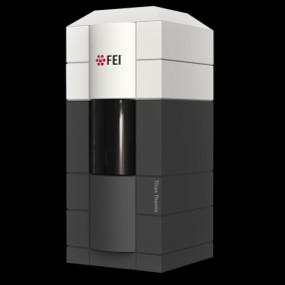 Model: Titan Krios / Image courtesy: FEI Company |
 Movie
Movie Controller
Controller


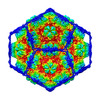
 Z
Z Y
Y X
X







